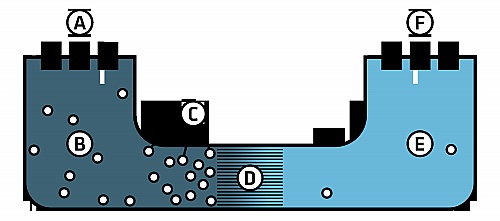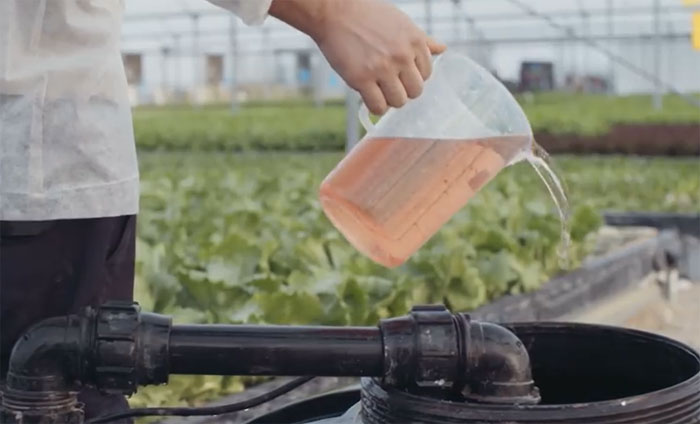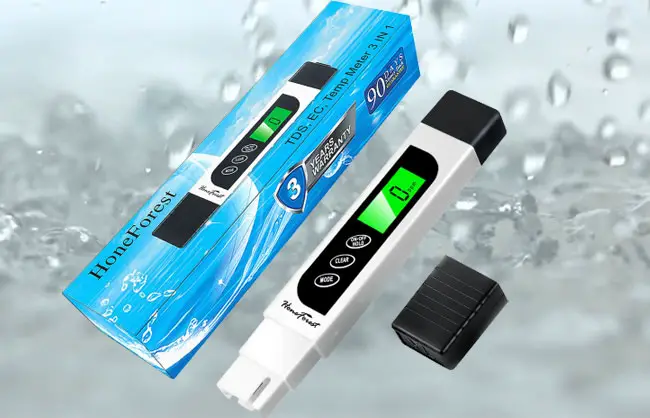If you are concerned about lowering the sodium in the soil, then it is ideal to use the green reverse osmosis (RO) system in your garden. Did you know that all vegetables and flowers you plant in your garden will grow beautifully and healthily when you have a quality filtration system?

What is Green Reverse Osmosis?
RO water is the most commonly used water purification method among those growers. Green reverse osmosis (RO) is a technology that utilizes the water purification process, which forces water through a specific semi-permeable membrane and splits up the contaminants from your water. It’s a machine that separates dissolved solids from your water as the water passes through it.
The result is water that is effectively treated from behind the membrane. The collected impurities are eventually washed away. You would need to replace the membrane periodically, as sediments will build up over time.
Reverse osmosis is a highly effective method to remove water contaminants such as:
- Asbestos
- Lead
- Heavy Metals
- Radium
- Chlorides
- Aluminum arsenic
- Fluoride
- Mercury
- Nitrates
- Radon
- Sodium
- Sulfide
- Cyanide
- Copper
- Benzene
- Chlorine
- Pesticides
It is an eco-friendly, cost-effective, and low-maintenance system that can be the ideal choice for efficiently operating your household. It moderates energy use while preserving a higher flow of water.
The Benefits
There are a variety of advantages to using this system.
- It is environmentally safe with innovative green technology
- It is energy efficient
- It requires minimum maintenance because there are no pumps or motors necessary.
- It requires no sanitizing because there is no water storage tank needed.
Additionally, reverse osmosis allows your plant to get better-tasting water that is clearer and crisper. Not only is the water safer and healthier for the soil, but also for rinsing your fruits and vegetables. Also, your children and pets will have fresh drinking water. With this water filtration system, you save money by not having to purchase bottled water anymore.
The other situation aside from unclean water where you’d want to take on a reverse osmosis system is if you’re looking to achieve a very tough botanical goal, like if you’re growing for weight or if you’re a breeder.
With the RO system installed, you’ll likely need a micronutrient solution to add the things removed by reverse osmosis. You’ll have a very high level of control over what’s in your water, and you can measure what happens without interference when you add in a certain amount of copper, calcium, or bat guano.
RO can be a great tool in removing confounding variables and allow you to make good decisions about other stuff. You will be able to figure out the micronutrient issues easily. Your plants will grow healthily, and you can also rest easily because you know that they are getting very pure water.
If you have an aquarium, reverse osmosis water may be the answer to keeping your fish safe and healthier. It will also allow your plumbing system to last longer because, after a while, hard water can clog your pipes and diminish the flow and pressure of the water. Reverse osmosis water produces soft water, which is low in mineral elements and doesn’t leave a deposit build-up in your pipes.
Other Benefits
For many years, some golf courses across the nation have been using the reverse osmosis process to irrigate their golf courses. Having access to water irrigation is vitally important to keeping the golf courses green in the golf industry. The reverse osmosis system is an added advantage to desalination. It removes more than 99% of the salt in brackish or seawater.
Is Reverse Osmosis Water Really Better for Plants?
Even though people claim that RO water is good for plants, some people disagree with this. They said RO water would get rid of all the nutrients in the water, and plants will not benefit from the water.
So which one should you think is correct?
Well, there are a few angles to inspect this. In my opinion, it’s not a question of whether you need to use RO water to water your plant. Because generally, the answer is no.
We need to ask whether, under what circumstances, we should use RO water. RO water is not necessary for most people, especially those growing their own crops in a fully developed country.
What are the Disadvantages of RO Water for Plants?
RO does actually cleans the water and many undesirable chemicals in the water due to human interference. But at the same time, the RO system also removes a lot of chemicals that plants need. Plants get many nutrients from the water, including some obscure nutrients that are useful to cannabis, such as copper.
By using RO, you may mess with your water and nutrient uptake in the plant. You are taking away nutrients that you would otherwise include with plain water, and this may result in unintended consequences like a copper deficiency. Copper is a particular chemical that your plant doesn’t use a whole lot of, but if there’s zero of it, your plant will not be able to get the necessary nutrient at all.
You need to know that whenever you go against the normal evolution of a plant that used the normal water that fell from the sky like the rainwater, which was full of all sorts of nutrients, you’re venturing into slightly murky territory now.
Besides, you need to remember that if you want to install an RO system, it can cost you a couple of hundred dollars.
Knowing How Polluted the Water is in Your Area
Before thinking of implementing an RO system for your garden, you need to judge the water quality in your area.
To give you some benchmarks, distilled water has zero parts per million (ppm) of dissolved solids in it. Reverse osmosis water has roughly 20 to 30 parts per million dissolved solids, depending on the RO system. This means that it has 20 to 30 milligrams per liter of dissolved solids.
Here is the chart of the different water ppm.
| Water Types | PPM |
| Distilled Water | 0 |
| RO Water | 20-30 |
| Tap Water (Developed Countries) | 140-240 |
| Tap Water )Developing Countries) | 250-300 |
| Tap Water (Under-developed Countries) | 300-500 |
For normal tap water, that’s got a big range to it. If your tap water is immaculate, you can get readings of slightly below 140 ppm all the way to about 230 ppm.
In many places around the globe, tap water comes in at around 250 ppm – 300 ppm.
For places with 300 to 500 ppm, it means your area has water with high dissolved solids water that isn’t particularly natural or clean water that is hard.
At that point, you should consider the benefits of cleaning your water with RO before you water your plants.
This is for you to take out all the unwanted chemicals. There will be some benefits to keeping your plant watered with clean water if your tap or rainwater is well above 300 ppm.
If you want to know how to measure the ppm of your water, you need to use a total dissolved solids meter.
If you got something to achieve or have dirty water, you should try RO. But for the casual grower who can easily access decent quality water with low ppm, you shouldn’t bother much with RO water. You may use tap water, which is already good enough.
How To Cut And Remineralize RO Water
When you’ve got pure RO water, you need to ensure that it’s replenished with the necessary minerals that help your plants live.
So what you’re going to need to do the first thing is to get hold of a total dissolved solids (TDS) meter. You need to put the meter in the water to test how much total dissolved solids are in there.
The reading of the TDS meter should be 0 ppm, and the reason you want 0 reading is so that you have a blank canvas and you know what you will be able to do with your water to reach your desired levels.
When it comes to re-mineralizing, there are 2 options you can choose from.
1. Cutting
You should only consider this option if the tap water you have has extremely high general hardness(GH) and carbonate hardness(KH).
If so, you would mix a certain percentage of your tap water with a certain percentage of your RO water. The purpose of this is to cut the levels of your tap water by the percentage level that you want.
For example, if you have a bucket of 10 liters of RO water and a bucket of 5 liters of tap water, then the 5 liters of RO water would cut your tap water’s general hardness and carbonate hardness in half.
If initially, the water you have is at 10 degrees, then it would become 5 degrees after cutting.
Remineralizing
If the tap water isn’t viable in terms of other parameters such as nitrates, you will not use the cutting approach.
The approach that you should be using is remineralizing. You will need to get some remineralize products for you to do so. You can get them either from your local store or buying them online.
One of the products that I use to replenish my general hardness is Seachem equilibrium.
What you’ll be doing with this is just making sure that you measure out the desired amount and then adding it to your RO water.
For example, with my 10-liter water change, I’m aiming for 4 degrees of general hardness. To achieve this result level, I would need to add 3 grams of equilibrium to the 10 liters of RO water.
Then you can use your TDS meter to test the water level. If the reading showing over 701 parts per million, this will be the 4 degrees of general hardness that I want.
If you don’t want to have the additional plant benefit and minerals contained in equilibrium but still want to alter your general hardness, you could use replenish instead. It works in the same way as equilibrium, but it’s a liquid form, and it doesn’t have the additional benefits for planted aquariums.
so you’d only really use this if you have a non-planted aquarium, and you wouldn’t really want to use this with a plant aquarium as well because this has sodium chloride in it and in high levels that could be damaging to plants
Now when it comes to raising your carbonate hardness, what you’re going to use is the sequin product called alkalinity buffer. You would use this product in parallel with the acid buffer.
You have to use these two together because you’ll be using the alkalinity buffer to target specific alkalinity or KH reading.
For example, if you want to get 4 degrees of carbonate hardness, you add 1.3 grams of alkalinity buffer into the 10 liters of RO water.
Depending on the pH you’re aiming for, you would use a certain amount of acid buffer to the amount of alkalinity buffer.
I always target 7 pH with my water changes, which I figured out is the best for my plants.



